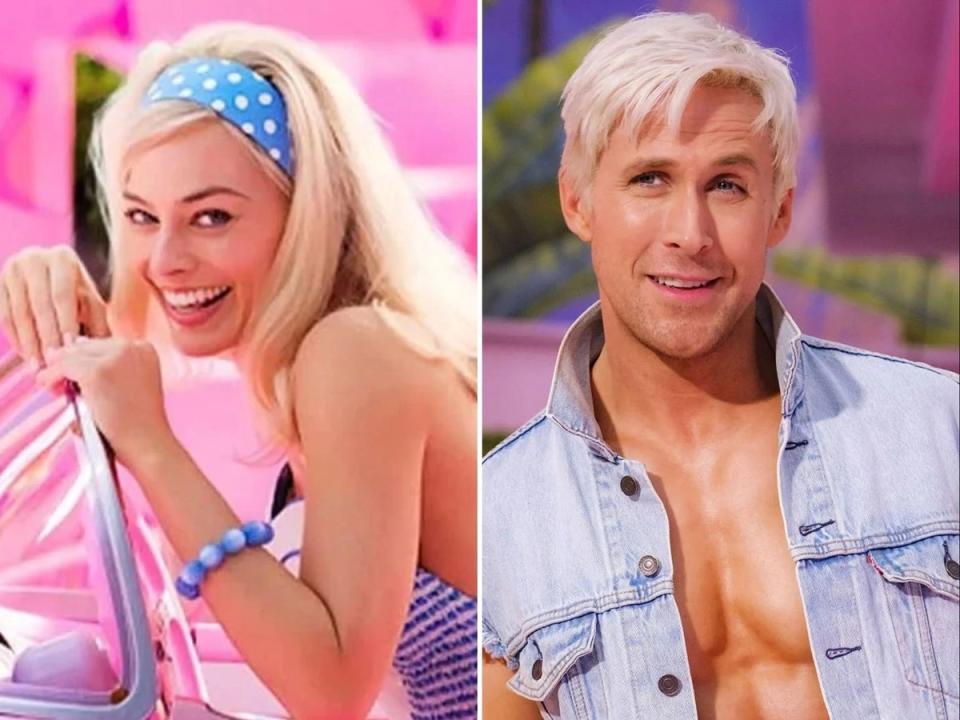Plastic fantastic: Barbiecore is the fashion movement turning hyper-femininity on its head

Take one look at Instagram right now and it won’t be long until the realisation hits you: we are all Barbie girls living in a Barbie world. Hot pink frocks. Fuchsia fittings in someone’s living room. A pleasing pair of pale pink roller skates. As the name may suggest, Barbiecore is about channelling all things pink, as per the traditional aesthetic of the original Mattel doll, which launched in 1959.
Examples include those viral on-set images from Greta Gerwig’s upcoming Barbie film – which stars Margot Robbie and Ryan Gosling as Barbie and Ken – the collaborations between Barbie and Zara and Balmain, and the myriad hot pink items currently on sale at luxury brands, such as Jacquemus, Balenciaga, Loewe and Valentino. The latter’s recent couture show was even awash with the shade.
None of this is surprising, though, with trend forecasting company WGSN having predicted the rise of Barbiecore in May 2020. That was when it announced that the colour of 2022 would be “Orchid Flower”, which is – you guessed it – a very Barbie-like, bright pink described by the company as a “saturated magenta tone”.
“The reason why this colour is thriving right now (and why we predicted it) is because it has an energising quality,” explains Sara Maggioni, head of womenswear at WGSN. “It’s fun, bold [and] has a familiarity to it that isn’t inaccessible like other vibrant shades.” Think of it as a progression from millennial pink, that dusky shade of rose that dominated the internet – and just about every Pinterest feed in existence – for the better part of 2016. “That might have adjusted the consumer’s eye to this colour level,” adds Maggioni.
It forms part of the current shift towards so-called dopamine dressing, ie wanting to reflect a happier and more upbeat mood through one’s clothing post-lockdown. In many ways, Barbiecore is one of many fashion trends that subverts the neutral palettes we sported when all of us were stuck at home for months on end.
But Barbiecore isn’t just about embracing a specific shade. It’s also about a particular mood, one that is about autonomy and confidence and can be channelled via what WGSN dubs a “sassier aesthetic”. “Think bodycon silhouettes, miniskirts, cropped tops, statement platforms, other fun and dopamine-boosting colours and prints,” says Maggioni. “Many of these items have been bubbling under for a while, predominantly driven by the consumer’s desire for wanting to dress up and go out and live life again.”
Given Barbie’s 1950s heritage, the rise of Barbiecore is also about fashion’s obsession with nostalgia – something that has become especially pertinent this year thanks to the resurgence of Y2K styles we’ve seen this season. “It’s a key factor for a demographic who lived through those times and are currently seeking solace in that familiarity,” Maggioni says, “but also among a new demographic that romanticises the past.” Even if that past is one they’ve not experienced themselves.
Barbie is like a female superhero who embodies the extremes of pink, girlie femininity and a grown-up glamour
This is why so many of the Barbiecore looks we’ve seen worn by celebrities – think Bella Hadid and Zendaya – have incorporated elements of Y2K culture, whether it’s the “girl power” attitude of noughties Bratz dolls, or films like Legally Blonde and Clueless. In recent weeks, it’s also led some fashion critics to ask what the rise of Barbiecore says about feminism.
Embracing Barbiecore taps into something deeper about women’s perceptions of their bodies and their sexuality, and how they’re changing. “For young women, it’s about flipping the male gaze on its head,” explains Maggioni. “Many of the people sporting the trend see it as a way of reclaiming the ‘bimbo aesthetic’ that was once synonymous with Barbie, and challenging what it traditionally means, showing [that] intellect and sexy clothing can go hand in hand.”
It’s worth noting, too, that Barbie itself has undergone a feminist – and more inclusive – makeover in recent years. Far from the white, blonde-haired and impossibly thin-but-big-breasted body type that dominated Barbie’s earlier incarnations, today’s dolls come in a wide range of body shapes, hair colours and ethnicities.

In 2019, Mattel launched a line of “gender inclusive” dolls that included dolls with physical differences – one has a prosthetic limb and another comes with a wheelchair. Meanwhile, the brand’s newly launched “inspiring women” series has proven its commitment to honouring women from all walks of life, with dolls modelled after everyone from Rosa Parks and Maya Angelou to English primatologist Dr Jane Goodall.
“Traditionally, Barbie is like a female superhero who embodies the extremes of pink, girlie femininity and a grown-up glamour,” says Rebecca Arnold, senior lecturer in the history of dress and textiles at the Courtauld Institute of Art. “But she is also highly adaptable, and Mattel has continually reimagined her since she was first created in 1959 to connect to contemporary ideals and attitudes.”
Evidently, Barbiecore is about much more than meets the eye. Yes, it’s about celebrating a joyous colour that is, in many ways, hyper-feminised. But it’s also about subverting societal expectations and reclaiming stereotypes of femininity. Just as feminists can wear makeup, they can also wear hot pink. And so can anyone else.


